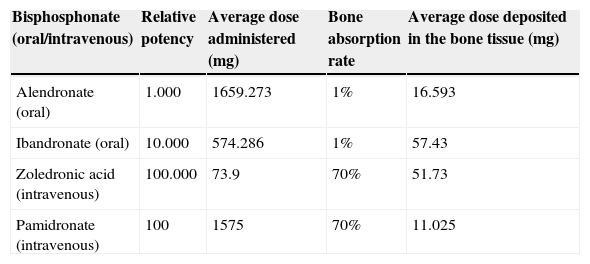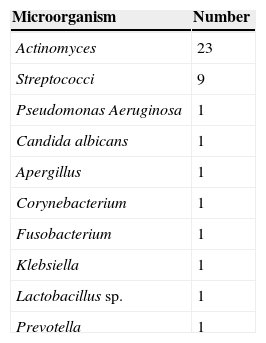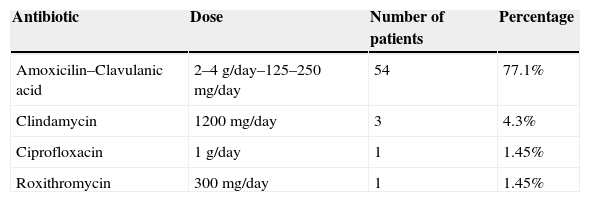Bisphosphonates are widely prescribed drugs whose principal capacity is inhibiting the osteoclast function. In 2003 a complication related to their administration, bisphosphonate-related osteonecrosis of the jaw (BRONJ), was described. The objectives of this study were to identify diagnosed cases of BRONJ in a third-level hospital over 8 years, evaluating the main features in relation to the disease, the bisphosphonate and the presence of local or general risk factors that could trigger the BRONJ.
MethodsPatients diagnosed with BRONJ in a center of reference for a population of 1100000 inhabitants were selected. Variables analyzed were classified into 3 groups: patients, bisphosphonate (focusing on dose and weighting dose/potency) and osteonecrosis.
ResultsSeventy cases were studied, 44 women and 26 men, with a mean age of 66.8 years. Eighteen patients received bisphosphonates orally and 52, intravenously. The mean time of administration was 26.53 months. In 67.1% of the patients it was possible to identify a local trigger, with the most common being tooth extraction (48.6%). Bone exposure was present in 89.2% of the cases, while 12 patients developed BRONJ without exposed bone, with only pain and/or chronic sinus tracts. Complete resolution was achieved in 58.6% of the patients, with a mean time of control of 16.28 months.
Conclusions25% of the BRONJ cases were related to the administration of oral bisphosphonates, especially alendronate. Zoledronic acid was the bisphosphonate that required the fewest milligrams to induce osteonecrosis. Single bone exposure was the most common clinical finding, especially in the molar mandibular region in patients with metastatic disease.
Los bisfosfonatos son fármacos con un amplio espectro de indicaciones cuya principal capacidad es la inhibición de la función osteoclástica. En el año 2003 se ha descrito una complicación asociada a su empleo, la osteonecrosis de los maxilares por bisfosfonatos (ONMB). Los objetivos del presente estudio son identificar los casos recogidos de ONMB en un hospital de tercer nivel durante 8 años, evaluando las principales variables en relación con la enfermedad, el bisfosfonato empleado y los factores de riesgo locales o generales que pudieran actuar como desencadenante en la patogénesis de la ONMB.
Material y métodoSe procedió a la selección los pacientes diagnosticados de ONMB en un centro de referencia para una población de 1.100.000 habitantes. Las variables analizadas se dividieron tres grupos: pacientes, fármaco (incluyendo el análisis de la dosis aplicada y la ponderación dosis/potencia) y osteonecrosis.
ResultadosSe recogieron 70 casos, 44 mujeres y 26 varones, con una media de 66,8 años. Dieciocho pacientes habían recibido un aminobisfosfonato oral y 52 por vía intravenosa. El tiempo medio de administración fue de 26,53 meses. En un 67,1% de los pacientes se pudo identificar un factor local desencadenante, siendo el más frecuente la exodoncia (48,6%). Aunque la exposición ósea estaba presente en el 75,7% de los casos, ocho enfermos padecieron una osteonecrosis sin exposición, manifestando la presencia de dolor y/o fístula crónica. El 58,6% experimentaron una resolución completa con un tiempo medio de control de 16,28 meses.
ConclusionesEl 25% de las ONMB en nuestra serie se relacionaron con la administración de un bisfosfonato oral, especialmente el alendronato. El ácido zoledrónico es el agente que menos miligramos precisa para desarrollar la enfermedad. La exposición ósea solitaria fue el dato clínico más habitual, afectando especialmente a sectores posteriores mandibulares en pacientes con enfermedad metastásica.













